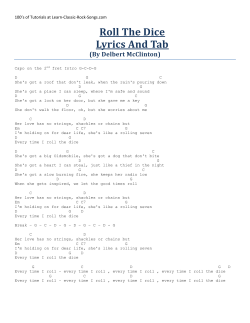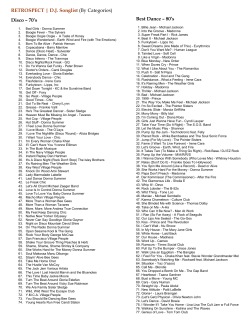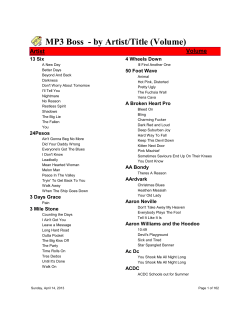
EARLY ROCK ‘N’ ROLL
EARLY ROCK ‘N’ ROLL THE ELECTRIC GUITAR ¡ ¡ ¡ ¡ Rock ’n’ roll elevated the electric guitar to a central position in American popular music. Engineers began to experiment with electronically amplified guitars in the 1920s. The solid-body electric guitar § Developed after World War II § First used in R&B, blues, and country bands Came into the mainstream with a somewhat dubious reputation § Carryover from the medieval European association of stringed instruments with the Devil § Associated with the music of marginalized regions and people CHICAGO ELECTRIC BLUES ¡ Urban blues tradition of the postwar era n Derived more directly from the Mississippi Delta tradition of Robert Johnson ¡ The rural blues tradition had almost completely died out as a commercial phenomenon by World War II. ¡ The old Delta blues emerged in a reinvigorated, electronically amplified form. MUDDY WATERS (MCKINLEY MORGANFIELD) (1915–83) ¡ “Discovered” in the Mississippi Delta by Allan Lomax in 1941 ¡ Moved to Chicago in 1943 ¡ Played both acoustic and electric slide guitar ¡ The single greatest influence on the British blues boom in the 1960s LISTENING: “HOOTCHIE COOTCHIE MAN” ¡ M uddy Waters, 1953 ¡ F eatures Muddy’s lineup in the early 1950s: § Two electric guitars § Bass, drums § Amplified harmonica ¡ C ombines blues form with strophic verse-chorus structure ¡ Typical Chicago electric/urban blues ROCK ’N’ ROLL, 1954–1959 ¡ ¡ ¡ ¡ ¡ The advent of rock ’n’ roll during the mid-1950s brought about enormous c hanges in American popular music. Styles previously considered on the margins of mainstream popular music were infiltrating the center and eventually came to dominate it. R&B and country music recordings were no longer geared toward a specialized market. The target audience for rock ’n’ roll during the 1950s consisted of baby boomers, Americans born after World War II. Muc h younger target audience COVER VERSIONS AND EARLY ROCK ’N’ ROLL ¡ Cover versions § Copies of previously recorded performances; often adaptations of the originals’ style and sensibility, and usually aimed at cashing in on their success § Often bowdlerized imitations of R&B songs § Helped fuel the market for rock ’n’ roll BIG JOE TURNER AND “SHAKE, RATTLE, AND ROLL” ¡ Big Joe Turner (1911–85) ¡ Called a “blues shouter” because of his spirited, sometimes raucous vocal delivery ¡ Born in Kansas City, started out singing with local bands ¡ “Shake Rattle, and Roll” was Turner’s biggest rock ’n’ roll record for Atlantic. LISTENING: “SHAKE, RATTLE, AND ROLL,” BILL HALEY AND THE COMETS (JUNE 1954) ¡ The lyrics were bowdlerized by producer Milt Gabler to ensure airplay on white radio stations. ¡ This song was only a minor hit when it was released. BILL HALEY (1925–81) ¡ ¡ ¡ ¡ Former DJ and western swing bandleader from Pennsylvania Dropped his cowboy image, c hanged the name of his accompanying group from the Saddlemen to the Comets In 1954, the Comets were signed by Decca Records. Moved toward the R&B jump band sound § Encouraged by A&R man Milt Gabler BILL HALEY AND THE COMETS Recorded commercially successful cover versions of R&B hits in the mid-1950s Largest success came in 1955 with “Rock around the Clock”, the first record to become a #1 pop hit Recorded in 1954 and not a big hit when first released ¡ ¡ ¡ § ¡ Popularized in 1955’s Blackboard Jungle, a film about inner-city teenagers and juvenile delinquency Rock Around The Clock EARLY ROCK AND ROLL STARS: THE RHYTHM AND BLUES SIDE CHARLES EDWARD ANDERSON (“CHUCK”) BERRY (B. 1926) ¡ Born in St. Louis, Missouri § § Absorbed blues and R&B styles One of the first and most successful black musicians to consciously forge his own version of blues and R&B styles for appeal to the mass market LISTENING AND ANALYSIS: “MAYBELLENE” ¡ Verse-chorus form based on the twelve-bar blues ¡ Chorus: “Maybellene, why can’t you be true”— follows twelve-bar blues chord pattern ¡ Verse—no chord changes—all on the “home” (or tonic) chord ¡ Verses build enormous tension, so that when the choruses and chord changes return, there is a feeling of release and expansion. RICHARD WAYNE PENNIMAN (“LITTLE RICHARD”) (B. 1932) ¡ ¡ Early career as an R&B performer § Hit the pop charts in 1956 with the song “Tutti-Frutti” § Delivered in an uninhibited shouting style, complete with falsetto whoops Epitomized the abandon celebrated in rock ’n’ roll lyrics and music § The sound of his recordings and the visual characteristics of his performances made Little Richard a strong influence on later performers. LISTENING: “LONG TALL SALLY” ¡ Built on the twelve-bar blues, adapted to reflect the more traditionally pop-friendly format of verse-chorus § The first four bars of each blues stanza are set to changing words—verses—while the remaining eight bars, with unchanging words, function as a repeated chorus. EARLY ROCK AND ROLL STARS: THE COUNTRY SIDE ELVIS PRESLEY (1935-77) ¡ Born in Tupelo, Mississippi n Moved to Memphis, Tennessee as a teenager ¡ The biggest rock ’n’ roll star to come from the country side of the music ¡ Presley’s extraordinary popularity established rock’n’roll as an unprecedented mass-market phenomenon. ¡ Known as the “King of Rock and Roll” ¡ Elvis is the best selling solo artist in the history of popular music LISTENING: “DON’T BE CRUEL” ¡ Based on the twelve-bar blues ¡ Presley’s vocal is heavy with blues-derived and country inflections. § § § § Striking regional accent “Hiccupping” effect on “please” Strong backbeat from R&B Opening electric guitar figure from western swing bands ¡ Imposed on all these diverse and intense stylistic elements is a wash of electronic reverb Don't Be Cruel BUDDY HOLLY (CHARLES HARDIN HOLLEY) (1936–59) ¡ Clean-cut, lanky, bespectacled ¡ Began his career with country music, fell under the influence of Presley’s and formed a rock’n’roll band, the Crickets ¡ “That’ll Be the Day,” rose to Number One on the pop c harts in late 1957 and established his sound. § Combined elements of country, R&B, and mainstream pop BUDDY HOLLY (CHARLES HARDIN HOLLEY) (1936–59) ¡ Holly’s vocal style exhibits elements of both fine country singing and fine blues singing, full of country twang and hiccups. ¡ Mixture of toughness and vulnerability ¡ The Crickets’ instrumental lineup § Two electric guitars (lead and rhythm), bass, and drums provided strong support for Holly’s voice. § During instrumental breaks, Holly’s lead guitar playing was active, riff-based, and hard-edged in a way that reflected the influence of Chuck Berry. LISTENING: “THAT’LL BE THE DAY” ¡ Form § Structured like a typical pop song, alternating verses and choruses of eight bars each § At the instrumental break, the Crickets play a twelve-bar blues pattern ¡ On some later records, like “Oh, Boy!” and “Peggy Sue,” Holly used a twelve-bar blues structure for the song itself ¡ That'll Be The Day
© Copyright 2025



















